Hermès Is "Costly" (But Not "Expensive")
The $270B+ French firm is at the top of the luxury world (worth the same as LVMH on 1/6th of the sales)...and apparently not worried about tariffs.
Thanks for subscribing to SatPost.
Today, I’m dropping the 7th episode of my Caffeinated Deep Dives podcast…and it’s about Hermès and the Birkin Bag.
Also this week:
Meta’s Antitrust Trial
The Business of Coachella
…and them fire posts (including Rory McIlroy)
Hermès and the Birkin Bag
Back in December 2023, I recorded an episode of my Caffeinated Deep Dives podcast about Hermès and the making of the Birkin Bag (Spotify, Apple, YouTube).
I’ve been sitting on the episode but the recent global trade madness is an opportune time to publish this bad boy. Why? The Hermès position at the top of the luxury world has held steady amidst the threat of tariffs and a looming recession…at least based on the company’s stock performance relative to key competitors.
Year-to-date, Hermès is flat while LVMH, Kering and Wendy’s are all down at least 20%+.
To be sure, these aren’t an apples-to-apples comparison. The aforementioned competitors own multiple brands that target different income brackets:
LVMH: Louis Vuitton, Christian Dior, Fendi, Givenchy, Bulgari, Tiffany & Co., Moët & Chandon, Sephora and various other names that I know about through osmosis from my wife over the years (on the business front, LVMH’s alcohol segment makes up ~1/6th of sales and is down sharply in recent quarters).
Kering: Gucci, Saint Laurent, Bottega Veneta, Balenciaga, Alexander McQueen etc.
Wendy’s:Big Bacon Claccis, Frosty, JBC, Baked Potato, Spicy Chicken Burger
While Hermès does offer relatively “affordable” goods to get customers onto its buying ladder (sandals, lipstick, scarves, bracelets, tableware, towels, hats), the main event is still the brand’s ~$10k hand bags (e.g. the Birkin and the Kelly).
The recent tariff madness is unlikely to dissuade Hermès customers from buying these bags. When asked about higher custom duties during an earnings call in February, Hermès CEO Axel Dumas went hard in the paint and said that he’d pass the costs along: “We'll increase [prices], and our American customers will understand and will remain loyal. And those who find it too expensive will come to…Paris.”
THE CUSTOMERS WILL UNDERSTAND!!!!! AND WILL REMAIN LOYAL!!!
IF YOU WERE ALREADY DESPERATE TO BUY A BIRKIN BAG FOR $10K BEFORE ANY TARIFFS, ANOTHER 10-20% LITERALLY MAKES NO DIFFERENCE.
IN FACT, HERMES BAGS ARE A “VEBLEN GOOD”, A PRODUCT WHOSE DEMAND INCREASES WITH PRICE!!!!!
I’M WRITING IN ALL CAPS TO HAMMER HOME THE POINT THAT HERMES’ AMERICAN CUSTOMERS WILL PROBABLY REMAIN LOYAL! I HOPE THAT’S COMING THROUGH.
Hermès clearly has pricing power with financials that are comparable to a software firm when you consider its gross and operating margins are 70% and 40%, respectively (also like software, Hermès customers are a source of recurring revenue as they buy increasingly more expensive items to ultimately score a Birkin or Kelly).
In the luxury world, Hermès does truly seem to be a “1 of 1” brand. It’s elevated itself above the fray and few comparisons actually make sense.
Sure, things could change but here’s another stat to show how Hermès has separated itself from the pack: last week, it briefly surpassed LVMH in market cap despite having a fraction of the sales. Now, both luxury giant’s are valued at ~$280B but Hermès is doing it on 1/6th of the revenue ($17B vs. $90B in 2024).
A year ago, Hermès was worth ~50% of LVMH.
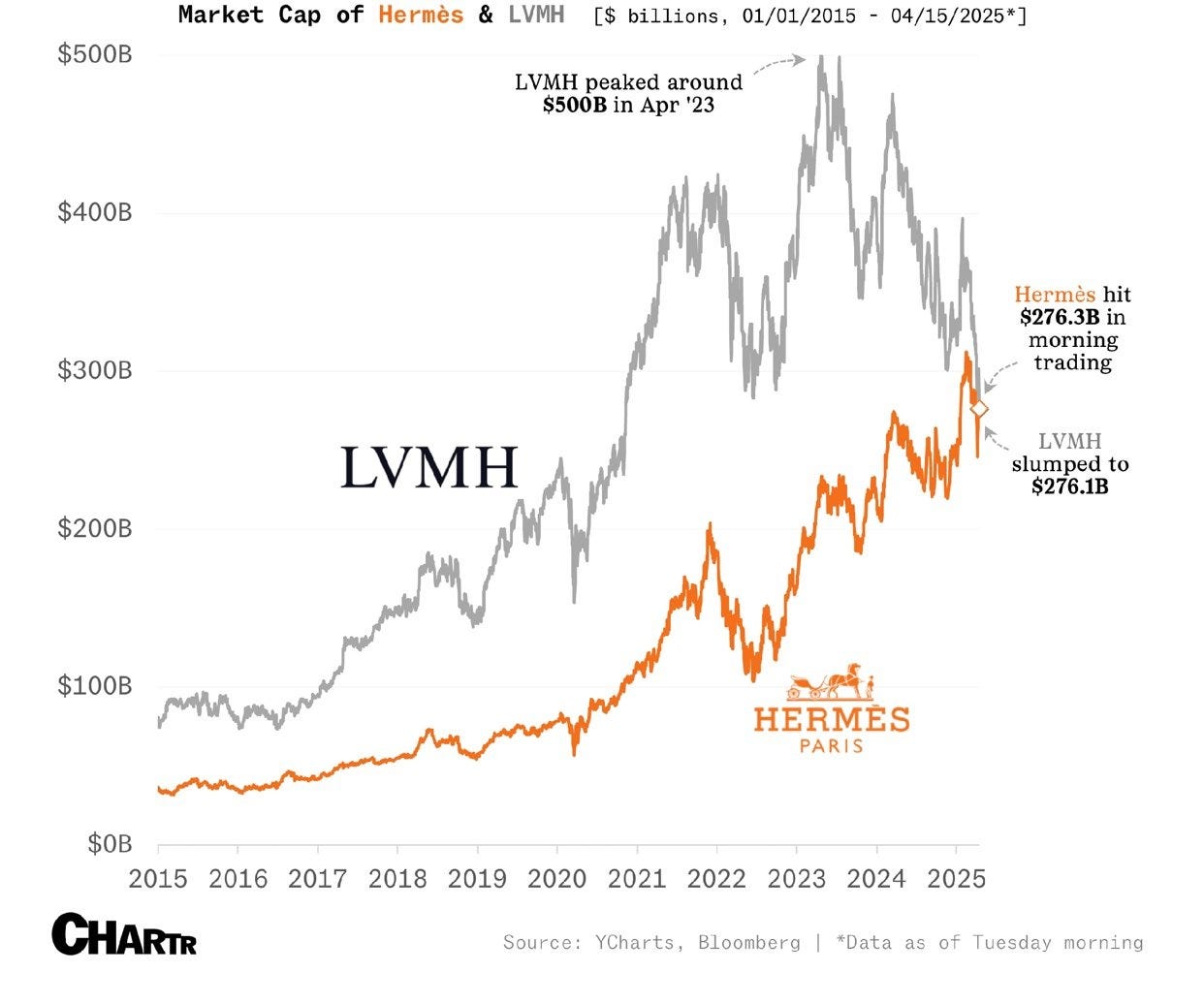
Here’s a very random stat about Home Depot and Hermès, per the Wall Street Journal:
The garden business rakes in about $20 billion a year for Home Depot—more than appliances, lumber or paint. It’s one of the biggest departments of the biggest home-improvement retailer, covering everything from live goods like plants, flowers and shrubs to soils, grills and patio furniture. In fact, it’s so big that Home Depot makes more money from its garden divisions than Hermès does from all of its luxury goods.
With or without a gardening aisle, Hermès is cooking and my podcast walks through how it became the crown jewel of the ultra-high end luxury world (listen at Spotify, Apple, YouTube):
History: Hermès was founded in Paris in 1837 and is being run by 6th-generation descendants. Its founding was linked to the rise of luxury brands that filled the “status” vacuum in the decades after the French Revolution abolished the French monarchy. Today, someone could raise $1 trillion to launch a luxury brand and it would be impossible to recreate that origin story (unless they used that massive bounty to build a time machine; in which case, all bets are off).
Link to Royalty: Also impossible to recreate is the fact that Hermès founder Thierry Hermès literally stitched horse saddles for Napoleon III and other 19th century European royalty…and then Queen Elizabeth started to rock the silk scarves in the 20th century. Barring the invention of that time machine, the Kelly and Birkin bags have similarly impossible to re-create origin stories.
Craftsmanship: A single Birkin Bag takes 15-25 hours to make and over 2+ years to train someone to learn the handcrafting techniques. The vast majority of Hermès products are made in a French “atelier” (or workshop, of which Hermès has ~60 in the country). This regional connection is crucial to the brand’s allure (Hermès does have some smaller workshops in Switzerland, Italy, the UK, the USA, Portugal, and Australia).
Controlling supply: Hermès expertly manages its output at every level (from its retail network of 290+ store to the end customer) to make sure no one actually knows how much inventory is available, which creates that feeling of scarcity.
Creating Desire: A new customer can’t just walk into an Hermès store and buy a Birkin or Kelly bag. Rather, they have to purchase a number of ancillary items and build relationships with a sales associate to get the opportunity to buy a bag. Waiting is part of the process.
Notice that each of these bullet points have a “time” element. History and lore is related to “time”. Craftsmanship, scarcity and waiting are related to “time”. Perhaps unsurprisingly, Hermès CEO Axel Dumas has quipped that “what we do at Hermès is sell time.”
Since the tariff trade war began earlier this month, a bunch of Chinese bag manufacturers have created TikToks showing how a lot of the luxury industry depends on Chinese labor. There are even claims that Chinese Birkin knock-offs are on par with the original. That’s literally impossible. You can’t buy the story and the heritage and the connection to France. The “time” that Hermès has cultivated. The bag could have comparable material and even craftsmanship, but the other factors all combine to create the status that justifies the 5-figure sticker price for the end buyer (it’s not for me, but I get it).
The net worth of Hermès’ main buyers does shield the firm from the worse of any economic slowdown. However, it also limits the addressable customer base. But the brand is clearly fine with that trade off, especially if it means they can gatekeep Vietnamese-Canadian guys that have an affinity for Kirkland sweatpants and write newsletters called SatPost (it’s fine, I get it).
Other than the tariff situation, two other notable developments happened since I recorded the podcast episode: 1) actress Jane Birkin — the namesake of the bag — passed away in July 2024, RIP; and 2) in March 2024, a number of Hermès customers in California filed a class-action lawsuit alleging that the company was violating anti-trust rules.
What’s the legal jist? As noted above, a new Hermès customer can’t just buy any item when they walk in a store. Hermès wants people to get on a sales ladder with a series of purchases. The lawsuit says this arrangement should be considered “tying”, which — in anti-competition lingo — is when a seller makes the sale of one item contingent on the purchase of another item.
Apparently, Hermès encourages “tying” through its compensation scheme: sales associates only make commission on accessories and ancillary bags (1.5% to 3%) but nothing on Birkin or Kelly Bags. As Charlie Munger famously said “show me the incentive and I’ll show you the outcome.” Understandably, if you’re getting fresh commission on accessories, you’ll want to push that.
Is that compensation structure anticompetitive, though? California judges have so far been skeptical and — in December 2024— the creative director of Hermès (Pierre-Alexis Dumas, cousin of CEO Axel) went on 60 Minutes to make the case that Hermès simply doesn’t have the supply for all buyers due to the bespoke nature of its craftsmanship.
Dumas explained why Hermès was unable to work faster to crank out more product:
Well, speed is the structuring value of the 20th century. We went from horse carriages to the internet. Are we going to be so obsessed with speed and immediate satisfaction? Maybe not? Maybe there is another form of relation to the world, which is linked to patience. To taking the time of making things right. You cannot compress time, at one point, without compromising on quality.
Let me translate that in all-caps: “WHAT WE DO AT HERMES IS SELL TIME!”
Another part of the 60 Minutes segment was devastating…to me, because Dumas was asked for the difference between “expensive” and “costly” and replied:
“[Hermès] is not expensive. It's costly…The cost is the actual price of making an object properly with the required level of attention so that you have an object of quality. Expensive is a product, which is not delivering what it's supposed to deliver, but you've paid quite a large amount of money for it, and then it betrays you. That's expensive.”
Damnit, that’s some slick wordplay. Since then, my wife has been expertly using Dumas’ nuance between “costly” and “expensive” while discussing various Hermès products…and I’m unfortunately inclined to agree.
Well played, Hermès, well played.
***
PS. Reminder, you can listen to the Hermès (Birkin Bag) episode Spotify, Apple, or YouTube.
PPS. Here are my other six Caffeinated Deep Dive episodes:
Always appreciate them fresh subs and likes 🙏🙏🙏
This issue is brought to you by Liona AI
Launch a GPT Wrapper in Minutes
As many of you SatPost readers may know, I’ve been building a research app for the past few years (Bearly AI).
Over that span, I’ve drank over 677 sugar-free Red Bulls while my co-founder built a flexible backend to manage all of the major AI APIs. We turned that backend into a product called Liona AI.
This easy-to-use platform lets your users and teams connect directly to OpenAI, Anthropic, Grok, Gemini, Llama, Cursor and more while you maintain complete control over security, billing, and usage limits.
Meta’s Antitrust Trial
Speaking of antirust, the US government brought an antitrust lawsuit against Facebook and Zuck Daddy Flex in 2020. The trial began last week and the Federal Trade Commission (FTC) is out to prove that Meta has monopolized the market for “personal social networking services”.
Ultimately, the government wants to unwind two of Meta’s largest acquisitions: $1B for Instagram in 2012 and $19B for WhatsApp in 2014. Why? The allegation is that Zuck bought these companies to quash competition.
I remember when the Instagram deal happened and I threw in my grossly unqualified peanut gallery opinion (“A Billy?!?!? $1B For Instagram? The photo filter thing?!”). It was a few months before Facebook’s IPO. Don’t think anyone in the world (not even Zuck) thought Instagram would one day be worth $500B.
That’s one challenge for the government.
Another challenge is that the government has had to narrowly define Meta’s competitive landscape. The “personal social networking services” classification was more relevant when the OG Facebook was primarily a “friends and family network”. That explains why the government identified Meta’s main competitors as Snap and…MeWe (?!?!?!?!). Meta is much more a general entertainment product now including hyper-targeted infinite scroll videos and a lot of AI-generated shrimp Jesuses.
At this point, it’s really competing with Netflix, Spotify, YouTube, X, TikTok and any form of digital distraction. Meta can make the case that, “yo, how can we be a monopoly when there are so many other options that people can easily switch over to?”
The Verge has a useful blog-like feed on the trial that should last a few months and there were some gem insights from the first week:
Zuck admits that TikTok has slowed down Meta’s growth “dramatically”.
Instagram got so successful that it was impacting the main Facebook app and Zuck considered spinning IG off into its own company (when he acquired the company, he thought it might grow from 10m to 100m users over 5 years; instead, it grew to 1B users).
Zuck’s charm offensive with the Trump White House definitely looks like an attempt to head off this case. The WSJ reported that Zuck offered the FTC $450m to settle the case and avoid trial. It was a Craigslist type of low-ball opening offer when you consider that the FTC wanted $30B…and obviously didn’t work.
I’ll update details when the trial is complete. In the meanwhile, let me flag this fascinating e-mail exchange between Zuck and Snap CEO Evan Spiegel.
In 2013, Snap was growing very fast and Zuck offered $3B for Spiegel’s startup. Spiegel seemed non-committal and told Zuck he thought he could build Snap into a $10B+ business. Zuck felt this was just a negotiating tactic and came back with $6B. Spiegel walked away from the deal and here’s one of their last exchanges, per Zuck:
[Evan and I] talked for a few minutes after that where he reaffirmed that he thought staying independent was the right path, especially since economically we were so far apart. I didn't press him on this since the point of the call was to close out the process.
After that, I couldn't shake the nagging feeling that his range and ours might not be so different, so l called him back and told him it would bug me forever if I didn't ask him whether he had actually done the analysis I'd asked about what number he'd sell at or whether he had just decided he wanted to stay independent no matter what. He told me he had done the analysis but hadn't wanted to call me because he was afraid he'd offend me. I told him he wouldn't offend me and he finally shared that his number was $8b with majority cash, or some structure that would be equivalent to him to as if he had sold the company for that much. I told him it was crazy but I wasn't offended, wished him luck and then we got off the phone again.
He owns 25% of the company, so it seems likely what he really wants is to make $2b personally pre-tax and $1b post-tax. In the structure that l'd proposed before, we offered $3b for the company and $1b in retention packages for him and his co-founder. That was equivalent to as if we bought the whole company for $5b from his perspective, since he'd get $0.50 of every $1 of retention package and only $0.25 for every $1 of consideration for the company.
The crazy thing is that if the high end of our range is $5-6b, then it may still be possible to get this done at the very highest end of this range. If we offered $4b for the company and $2b in retention, that would cost us $6b but would achieve his financial goals. Alternatively, if we offered $4.5b for the company and $1.5b in retention, that might be more palatable to the investors and although it wouldn't quite achieve his financial goals, it might be close enough that he'd compromise.
Today, Snap is a $13B company while Meta has 10x’d since the offer.
Zuck has obviously snatched most of Snap’s best ideas in the past decade (Stories, Glasses), which has lead to Spiegel (somewhat hilariously) putting this in his LinkedIn bio: “VP of Product at Meta”.
The Business of Coachella
The giant music and arts festival kicked off last week. This year’s headliners for the festival are Lady Gaga, Post Malone, Green Day and Travis Scott. Solid line-up tbh. I fux with Post Malone hard. Probably the last “new” artist I really got into over the past decade. Don’t judge. Most people crystallize their music tastes in their teens, so pretty experimental of me all things considered.
Anyway, the most viral video from the fist weekend did not involve an artist. It involved someone buying some a few tacos, a plate of nachos and lemonade for $102.
That price is obviously a massive rip-off but you’re a captive audience once you step on Coachella grounds.
A related stat helps to explain the reaction to concession prices: this year, 60% of the 100,000 people attending the two Coachella weekends paid for their $599 ticket using a payment plan system. Definitely a younger crowd. The entire weekend is $1,000+ per person on average taking in ticket, F&B and merch (which equates to over $100m for Coachella across both weekends).
Billboard has details on the payment plan for the $599 entrance ticket:
Upfront payment: $49
Payment timeline: 3 months (artists are typically announced in January, giving attendees enough time to make a decision and then pay by April)
However, this is different than Klarna-type “Buy Now, Pay Later” (BNPL) instalment plans:
How Klarna works: In the BNPL model, Klarna would payout Coachella organizers in full for the ticket then recoup from attendees. It’s extending credit to the buyer. Klarna makes money on merchant and processing fees, as well as interest if the buyer doesn’t meet all of the instalment payments on time.
How Coachella’s payment plan works: Attendees puts down $49 and have ~3 months to pay the rest. Concert lineup comes out in January, so they’ll be paid off by the April event. Coachella partners with the ticketing company (eg. Ticketmaster), and the payment plan “is offered as a service in exchange for the festival promoter’s business”. Crucially, the ticketing company isn’t providing credit. Rather, it is just passing along the payment to Coachella as the buyer completes the payment plan. There is a $41 fee for this service, which is ~8% of the ticket price.
My friend Turner Novak genius-ly dubbed it “Buy Now, Party Later”.
This setup works for the largest festivals (Coachella, Glastonbury, Lollapalooza) but the broader industry is in a weird spot. It’s estimated that 90 such festivals were called off in 2024. A lot of these event organizers probably overestimated the post-COVID comeback of “live events”.
The Coachella organizers are fans of this model and even if someone misses multiple payments, they’ll allow buyers to use the down payment for next year’s concert. Why? Because they want them eventually in the door to absolutely mog them on a few fish tacos, nachos and lemonade for $102 (don’t even get started with booze).
One insider tells Billboard, “Festivals are now marketing a cheap down payment as their main call to action. The messaging is $20 down gets you in the door, or $50 down gets you started. It’s no longer about the artists, or the festival lifestyle — the message is, ‘You can afford this if you act today.’”
Putting myself in the shoes of a 20-something, I totally get it. While it seems pretty nuts that a $50 down payment is that enticing even though you end up paying the entire bill before the event, a “10% outlay” doesn’t seem that bad.
When I was living in Saigon and making less than $1,000 as a writer, I once flew to Shanghai…but added 19 hours to the trip to save $100. Instead of flying 4-hours direct to Shanghai for $300, I went on the very budget Air Asia for $200. But I had to first fly south 2 hours to Kuala Lumpur, then sleep overnight at the airport then fly 5 hours to a Chinese city outside of Shanghai and take a 3-hour bus. Then I blacked out within 10 hours of being arriving in the city. Truly idiotic in hindsight.
Back to Coachella: for top artists — but not TOP TOP artists — the festival still makes a lot of sense. It’s remains the top live festival (Glastonbury is probably 2nd) and a ton of eyeballs watch, including on the livestreams.
The money is decent and here is a cool heuristic based on the Coachella poster: this year’s headliners are making $5,000,000+ per weekend while artists in the 2nd row typically make $750,000 per weekend.
So, why don’t the TOP TOP artists do Coachella? Kendrick Lamar and Rhianna turned the festival down this year and other hitters have done so in the past. Trapital’s Dan Runcie wrote about the Coachella business a few year ago and explains:
Headlining the show is great for many superstar artists, but at the highest heights there’s a tradeoff. In recent years, the headliners get $4 million per weekend (but I heard from a source that Bad Bunny got $5 million). The artist on the second row got $750,000 per weekend. That’s a great payday, even for an artist selling out arenas. But for an artist like Taylor Swift, who can likely gross $10 million per night on her own stadium tour, then she may be leaving money on the table. This is where the Coachella documentary deals play a factor. Beyonce was rumored to be paid $20 million for the Homecoming documentary on her 2018 show, which made the experience worthwhile for her (and the Beyhive).
For other artists, Coachella is a brand-building signal to keep getting looks. Cardi B performed in 2018 and was paid just $70,000 per weekend. She spent more on her production, but she saw it as an investment. Cardi now gets paid $1 million for private shows regularly. She used a Coachella performance the same way a speaker uses a TEDx Talk. Sure, they weren’t paid. But that high-quality video lives on YouTube forever and will be the proof point to land more lucrative speaking and career opportunities.
Dear Coachella, your boy Trung is not greedy. If Post Malone doesn’t come next year, I’ll sing his songs….for $35k a weekend (I could use that money to buy a bag that rhymes with Hirkin).
Rory McIlroy’s Incredible Journey
Finally, huge congratulations to Rory McIlroy for winning the Masters last Sunday. The 35-year old Irish golfer threw that monkey off his back in a huge way. After winning 4 majors before the age of 25, many dubbed him the next Tiger Woods.
Then came an 11-year drought of majors before winning his first Masters and completing the career Grand Slam.
His origin story flooded the timeline including this bit on his family:
To fund his golfing ambitions, McIlroy's parents took on extra jobs. Gerry worked 100 hours a week; he cleaned toilets and showers at a local sports club in the mornings, served as a bartender at Holywood Golf Club from 12 to 6 pm, then returned to the sports club to work behind the bar in the evenings.
Rosie looked after Rory during the day and worked night shifts packaging rolls of tape at a 3M factory in Bangor, County Down. Due to their conflicting schedules, McIlroy's parents rarely saw each other during this period. Gerry later said: "I had no idea what else to do. I’m a working-class man. We wanted to give our only child a chance." After finding success as a professional golfer, McIlroy bought his parents a house in 2009, stating: "I’ll never be able to repay Mum and Dad for what they did, but at least they know they’ll never have to work another day. I’ll do whatever it takes to look after them.”
I’m not crying, you’re crying.
Back in 2013, Rory had signed with Nike after winning two majors. His first TV ad with Tiger Woods (“No Cup Is Safe”) was seen as a passing of the torch. He did win two majors in 2014 before the long drought. But the Tiger’s influence was a real as ever. Rory was a self-described "anorak" — British slang for “obsessive” — of Tiger and Nike captured that influence in another incredible ad (“Ripple”). Nike dropped another absolute banger when he won The Masters ("Sunday Pickup”).
So glad to see McIlroy get the money off his back. In the hall-of-fame for “getting monkey off my back” with Lebron winning one for Cleaveland in 2016, Leo winning Best Actor for The Revenant, Tiger winning the 2019 Masters and me taking my kid down in Monopoly Deal last night.
Also, The Masters always delivers on those memes. SHARED VIEWING CULTURAL EXPERIENCE, PEOPLE. That’s the money. The best template that came out of Rory’s incredible Sunday. It’s a 50-second clip (below) of him walking through the crowd after winning and taking it all in. It was clipped by parody account John W. Rich, who told me “I was sitting in the bar watching the coverage and when I saw this clip I ran home and cropped it because I knew it’d run.” There’s some inside meme baseball for you and the template blew up including glorious riffs including for the HR department and the Luka Doncic trade and parenthood (and another clip of Rory seeing The Masters champion locker room for the first time).
PS. Ken Griffey Jr. took these photos of Rory Mcilroy after winning The Masters. His transition from hall-of-game baseball player to ace sports photographer is up there with Colonel Sanders (lawyer to founding KFC) for all-time career pivots.
The backstory is awesome: Griffey Jr. picked up photography as a hobby because he wanted to watch his kids play sports without having dozens of people come up to him throughout the game. He started bringing camera equipment and was able to watch uninterrupted. Then, started chatting with his former teammate from the Seattle Mariners, hall-of-fame pitcher Randy Johnson…who is a legit sports photographer now.
And that explains this post:
Links and Memes
Some other links for your weekend consumption:
You know those “Day In The Life” videos? Literally, nothing in the world can prepare you for this one someone did about a Swinger’s Party…and how it went insanely viral on social. (Know Your Meme)
Video selfies of historical events…is a pretty solid use-case for AI (X/Justine Moore)
Another use case for AI was to automate call centres…but here’s one I didn’t think of: AI removing accents so someone from Bangalore could sound like “Josh From Texas”. (X/Shweta)
What is Costco like in France? Professional cook David Lebovitz visits one 50-minute outside of Paris (there are two in the country) and breaks it down. Less people eat free samples. Oversized sauces aren’t that attractive to regular shoppers (but fine for restaurants). Liquor aisle underwhelmed. Local selections include bake-at-home baguettes, macaroon, cornichon pickles, canelés and candied sour cherries. (David Lebovitz Newsletter)
A really good podcast about Michael Dell…from my buddy David Senra at the Founder’s Podcast. Dell founded his PC company in 1984 at the age of 19. The revenue ramp of first 15 years was insane: Year 1 ($6m), Year 5 ($258m), Year 10 ($3.5B), Year 15 ($25.3B). My University laptop was a Dell and I rode Limewire on that thing until the wheels fell off. (Founder’s Podcast)
…and them fire posts (including this Katy Perry one; she joined Lauren Sanchez and four other women on the first all-female space flight on a Blue Origin ship…she dropped this pre-flight quote “we are putting the ‘ass’ back in astronaut’” and created a viral image when she returned after the 4-minute space excursion and kissed the ground):


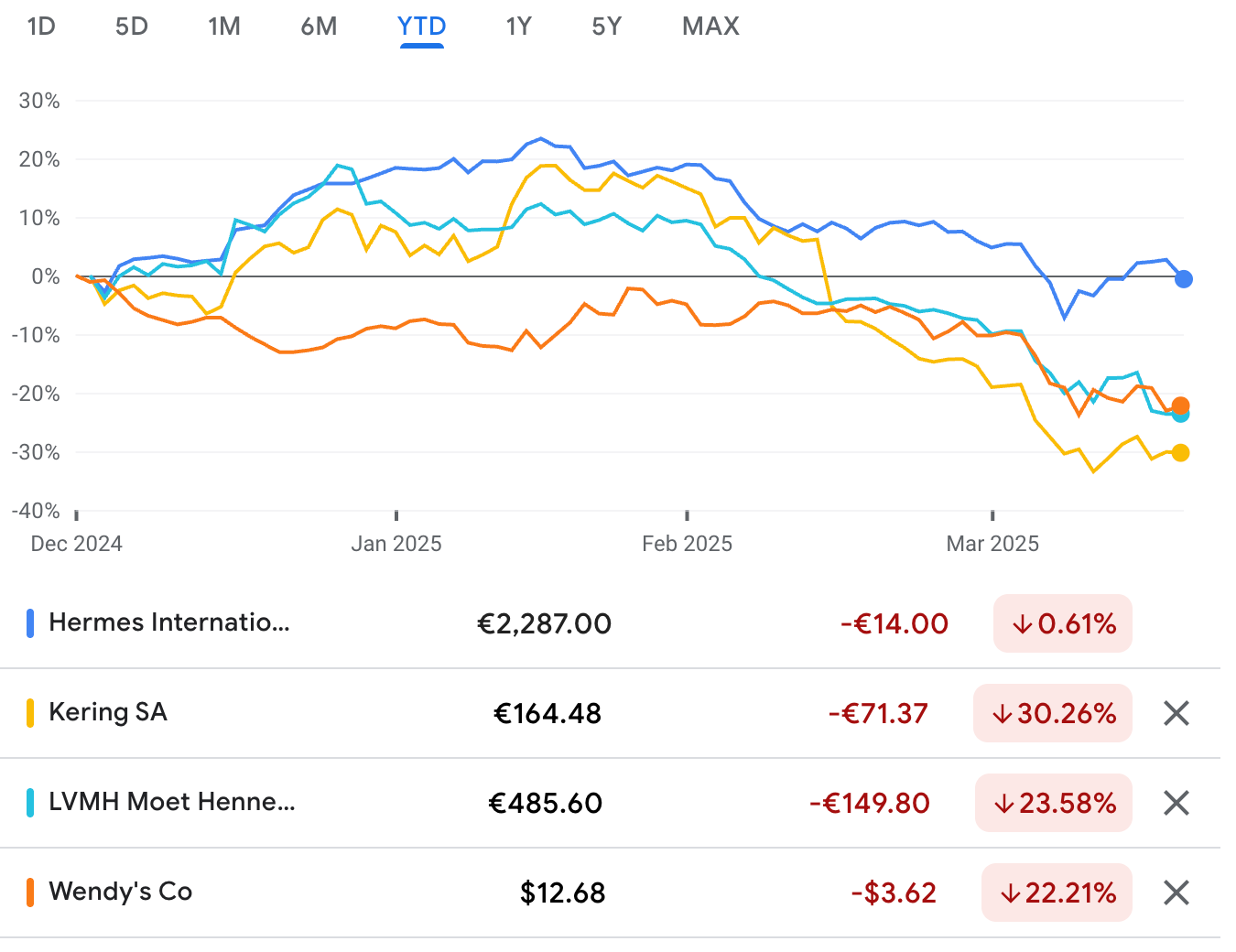
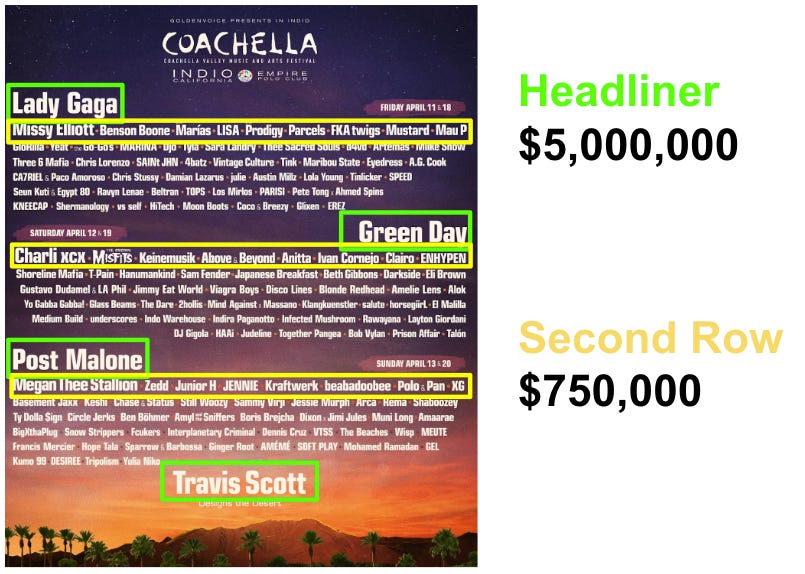
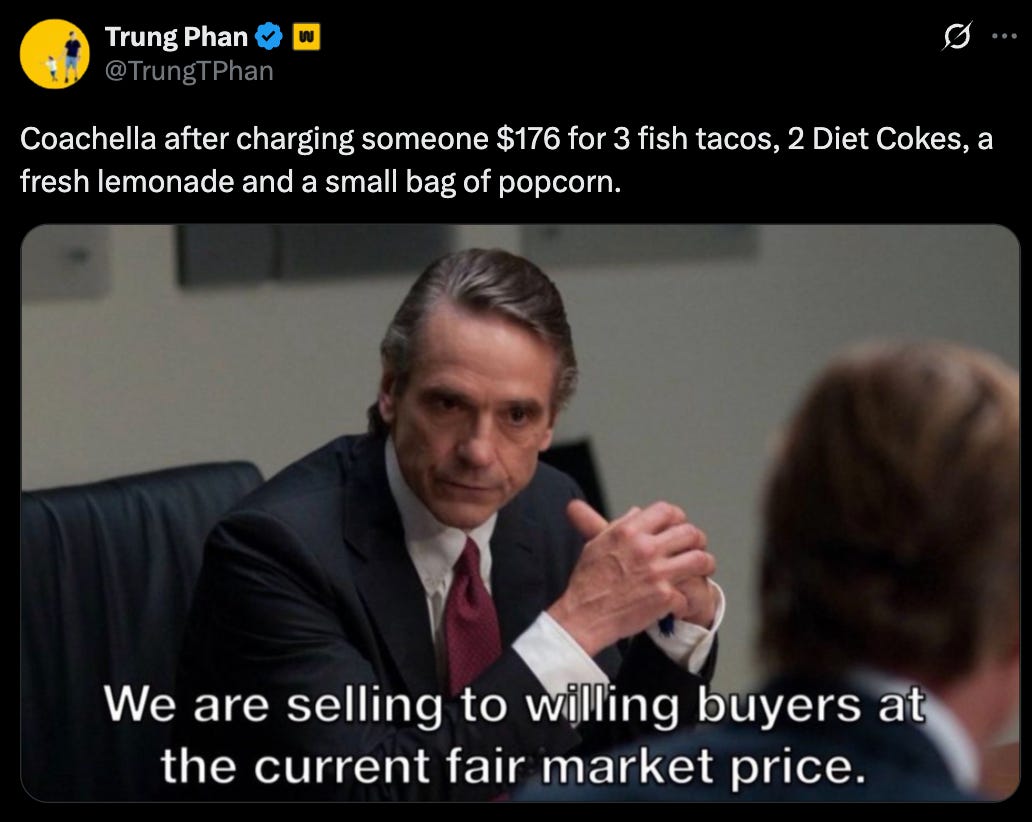


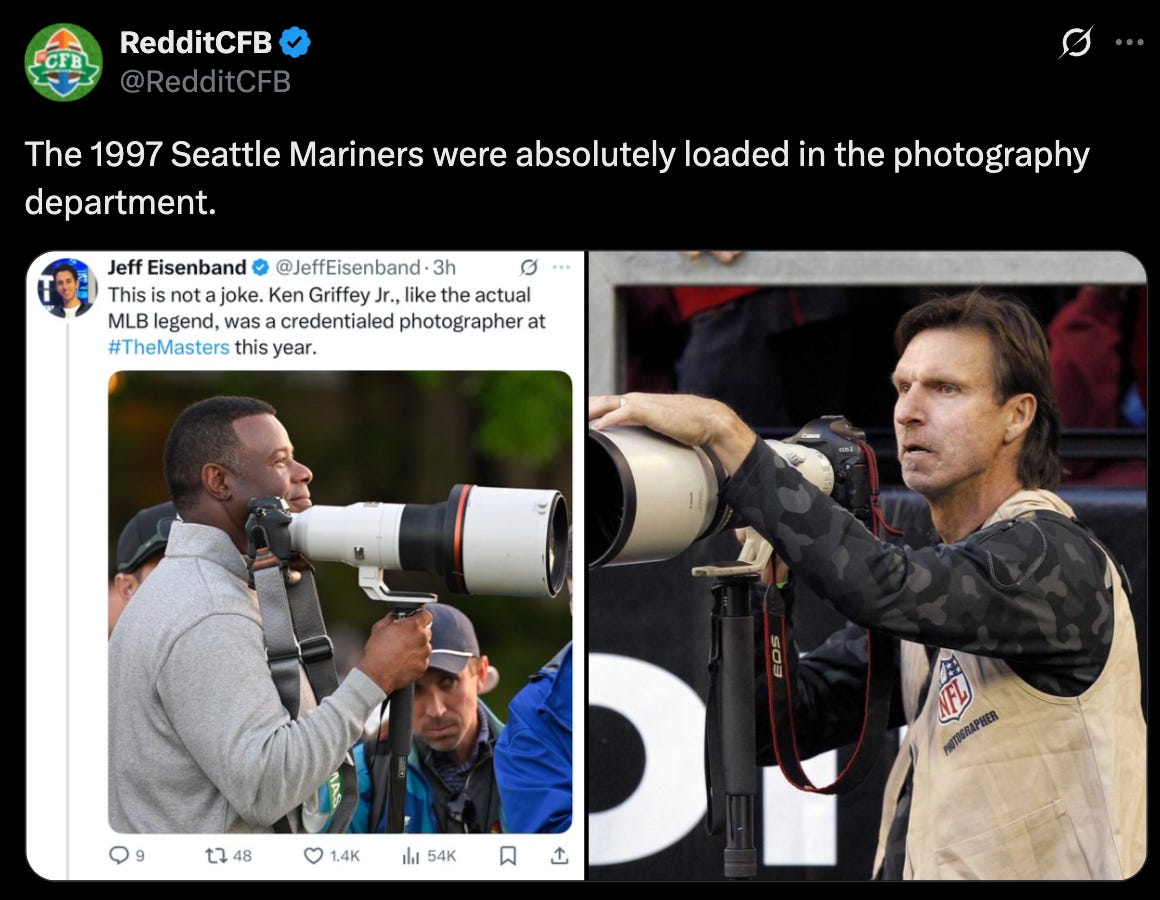
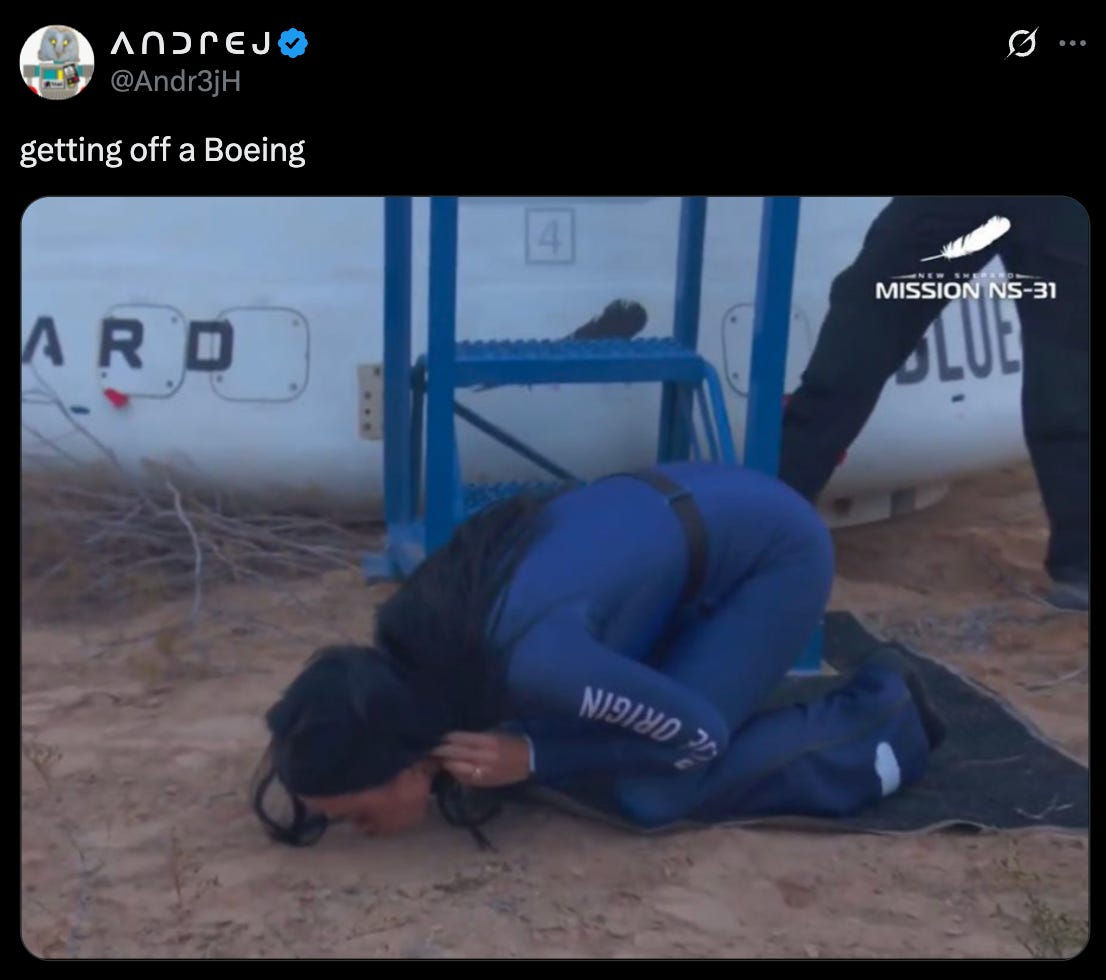

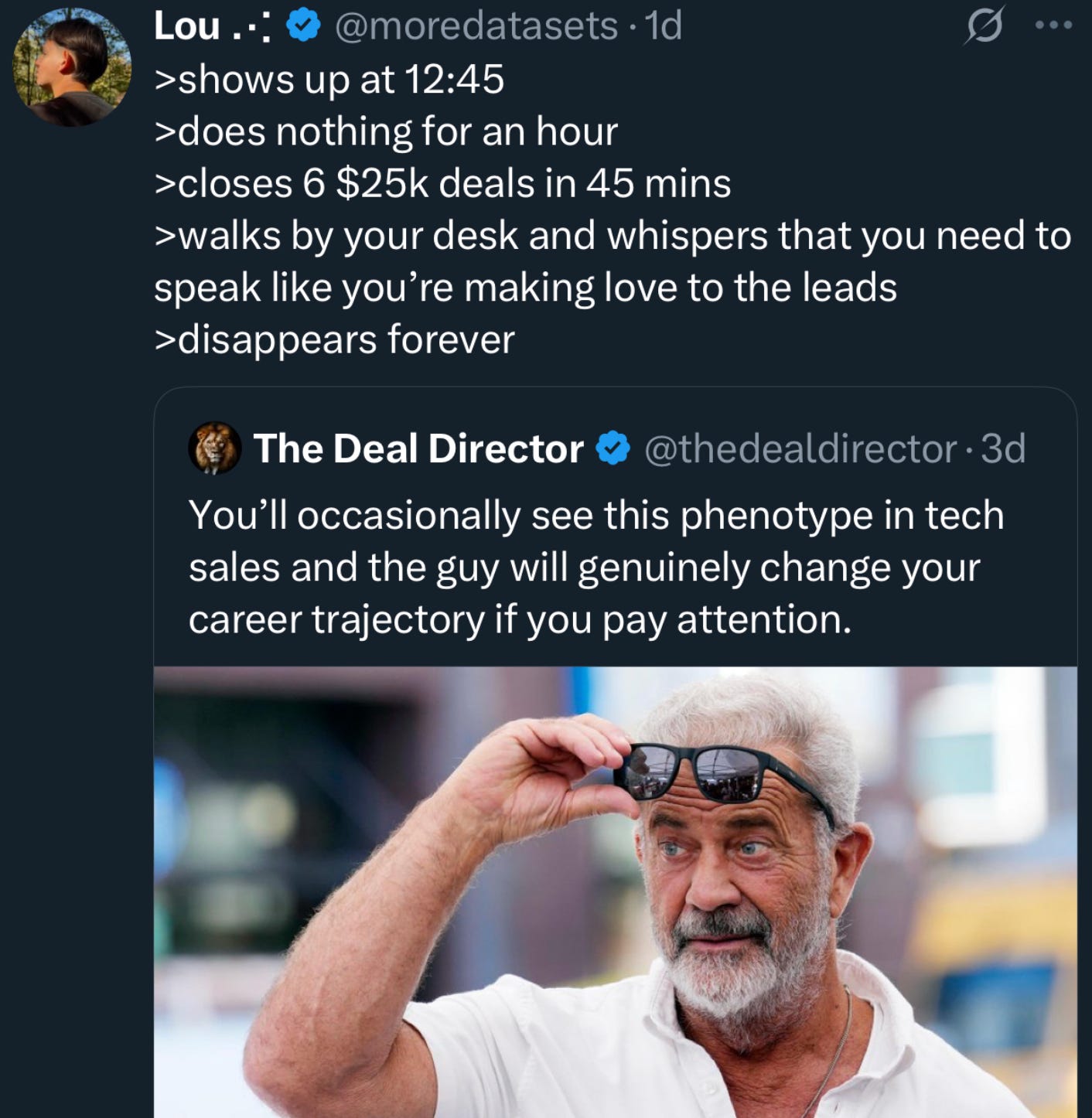
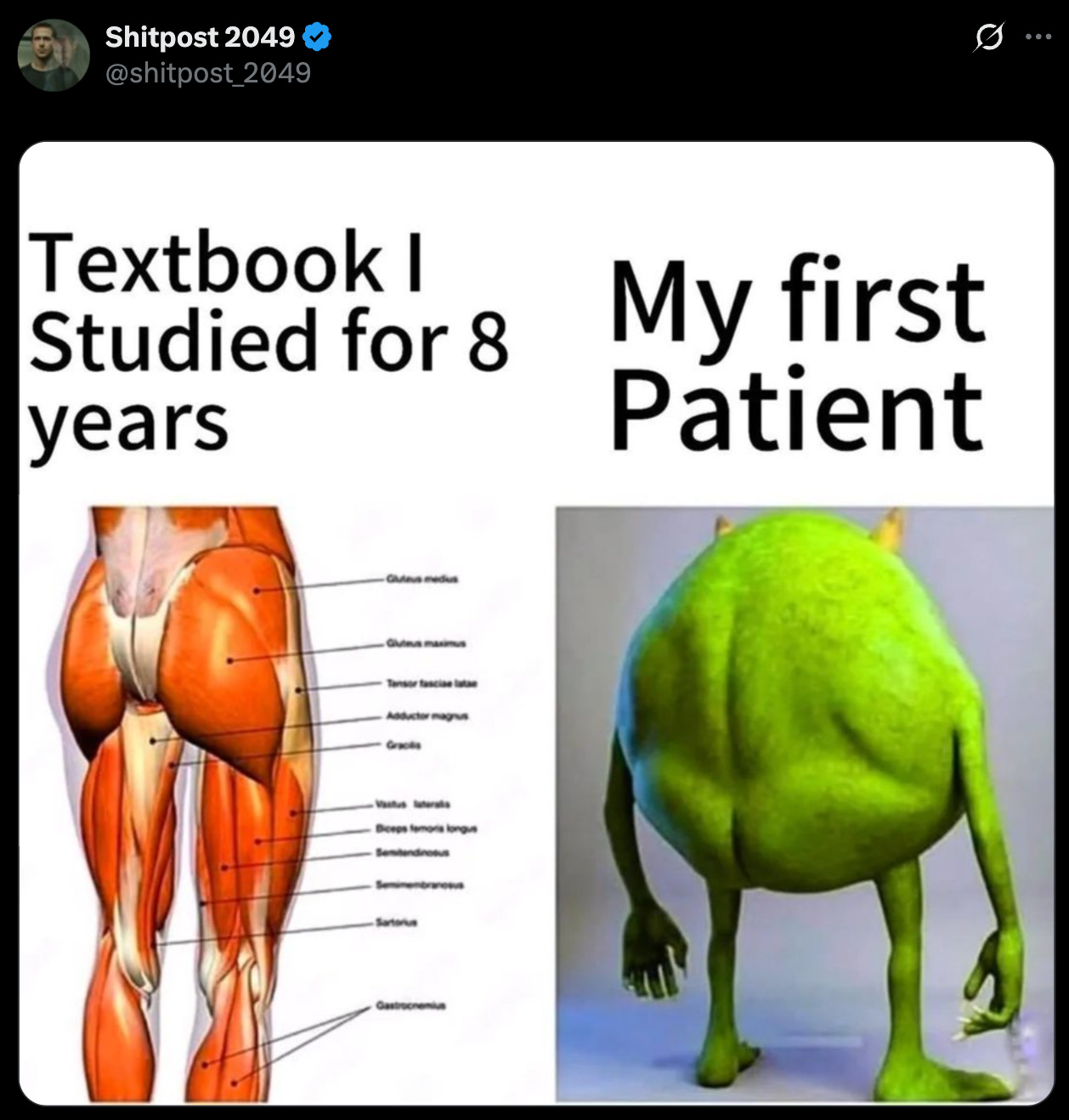

I know you've likely seen if not posted this before, but to get some idea of the labor of the handbags, the classic reference is https://www.tiktok.com/@liveyoursway/video/7228620602242895105 (he has others too)
Another banger. Merci. In other news, coincidentally the WSJ just referenced Hermès in this article about Home Depot’s garden category: https://www.wsj.com/business/home-depot-gardens-plants-flowers-hot-peppers-1792df6b?st=9X7GF5&reflink=desktopwebshare_permalink